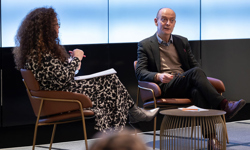Colin Morrison, non-exec director of Centaur and other media businesses, believes that radical change is required. Publishers need to start charging a premium rate for digital content and reduce their reliance on fast disappearing advertising revenues, instead building sponsorship packages with custom editorial content. Newsstand copy sales will diminish, so the future is in building subscriptions. But publishers need to watch out for new upstarts, who can offer video content, ecommerce and more community interaction. Colin urges rapid evolution: “I think we should all be preoccupied with re-thinking our approach to everything: costs, revenue, reader / user behaviour, staffing, skills, and technology. And don’t stop changing. However specific and seemingly self-contained your niche is, be endlessly curious and learn about what is happening in other markets: it can help you keep on top of your game and ahead of would-be competitors.”
Louise White, director at Briefing Media, and formerly group marketing director at Incisive, believes that niche publishers should focus on their core audience, and growing the revenue per subscriber, by creating added value bundles and membership packages. This doesn’t necessarily mean creating new products, just inventive packaging of what may already sit in your portfolio. But the bedrock of any complex subscriptions offer is top quality data and excellent subscriptions fulfilment and marketing analysis – sounds boring but without this, you are blundering in the dark.
Minal Bopaiah is Editor of Subscription Site Insider, based in New York, and encounters plenty of clever ideas that are working for niche publishers across the pond. Minal also exhorts publishers to premium-price their digital content and resist bundling it for free with print subs. Online, don’t give away too much free content before you ask for an email address, so you can start to build up a relationship with them. And it’s best to keep paywalls simple, so you don’t confuse your audience. Plus spend as much or more effort on retention techniques as acquiring new subscribers.
Duncan Tickell is commercial director for Immediate Media, and previously was MD of independent specialist publisher Magicalia. There he built a reputation for high-value multi-media solutions for key clients, building on editorial and design expertise. Duncan believes specialist markets have a great advantage in designing creative solutions for advertisers, with an enthusiastic community and highly targeted editorial. And this is the perfect route to avoid super-low commodity ad rates.
Stuart Dinsey, founder and MD of Intent Media, built up his B2B publishing business in computing, entertainment and music, and in December sold it to NewBay Media of the US. He sees the pressure on high street retail depressing copy sales, and an increasingly crowded event space. But readers and advertisers are becoming more tuned into digital products. Stuart’s focus is increasingly on taking Intent’s core video games brand MCV worldwide: with Pacific, Nordic and Indian versions, and advises even niche publishers to have an international strategy.
Rob Chambers is MD of Total Telecom, an award-winning independent B2B publisher. He echoes Stuart’s focus on international markets, and is seeing strong growth in Asia and Latin America. Rob is still launching conferences and awards, and is expanding into enterprise users. However, advertising revenue remains under pressure, with more focus on lead generation. Rob advises publishers to use LinkedIn and other social platforms to build their community internationally, and explore ultra niches.
Ben Wood is event marketing director at Incisive Media, responsible for a wide range of niche financial and professional services magazines, websites and events. Ben is focused on geo-cloning events, and also exploring new event models. He’s also been pondering his email marketing strategy; it has always been core to B2B marketing, but as technology and consumption change and products become more complex, it’s much harder to devise.
Owen Davies is CEO of hobbyist publisher My Time Media. His current focus is growing his ecommerce business, which started with their print magazines in modelling and crafts markets, but now is expanding into related sectors such as model railways where they have built a content website and online community which is driving a good proportion of sales. “Ecommerce may be a better way to monetize online content and communities than advertising. A magazine with a good subs base is a bonus, but not essential.”
Rebekah Billingsley was responsible for the mobile strategy of over 30 niche titles at Immediate Media, and now runs Big Cat Consulting. She sees the variety of platforms available as an opportunity for publishers, especially when reaching an international audience. Rebekah recommends launching mobile editions simply and cost effectively, and then improving as you learn. The hardest task is connecting print, web and mobile products when they are a mix of paid and free.
Luca Forlin, from the strategic partnerships team at Google, believes that as the pace of technology change continues to increase, internet users will shape the environment around themselves depending on their preferences. Brands that are “non-social” will become irrelevant and people expect to find their favourite content anywhere on any device. So publishers must consider how to include user content in their publications, and accommodate a growing range of screen sizes, including large phones or “phablets” that are 5” or 6” and not ideal for replica digital magazines. Video content is growing, so publishers cannot ignore moving images. And amid all this digital content, there is a growing place for live interaction with audiences, such as events or even retail outlets. Luca sets out “four new rules for publishers: 1. Follow your users, 2. Get ready for different devices, 3. Enhance and destructure your content and 4. Break boundaries”.
So the common themes are to premium price your digital content, and experiment with digital platforms. Also to create new subscriber packages and make sure your data and fulfillment is in good order. But keep questioning your tried and trusted marketing techniques and testing new approaches. Plus work with ad clients to create multi-layered marketing solutions. And there’s a persistent view that there are international opportunities even in niche markets, especially on web, mobile newsstands and in events. Publishers should also test out creating video content and creating ecommerce offerings.
Colin’s advice of remaining curious, looking out for new competitors and watching seemingly unrelated markets is sound.
An easy way to learn about experiences in other markets is to join these speakers plus many other innovative specialist publishers at the Specialist Media Conference at the British Library in London on 24 April 2013. Delegates can put questions to speakers in panel Q&As and in informal round table discussions.
Conference Details
Venue: British Library, London
Date: 24 April 2013












